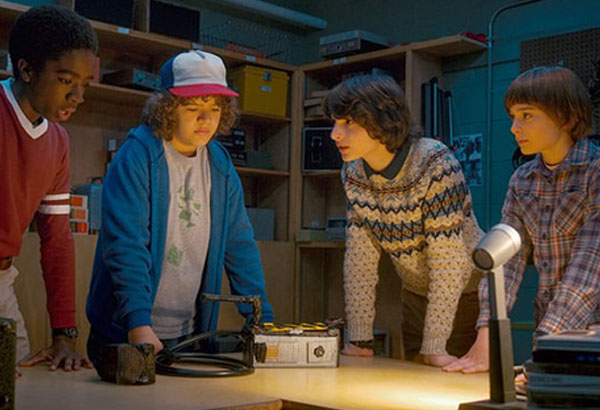Familiar things

Buoyed by nostalgia for the ’80s and for its own first season, Netflix’s Stranger Things 2 brims with the pure joy of familiarity.
Stranger Things is more than a television show. It is a state of mind. It is autumn; it doesn’t really exist here, but it is transmitted spiritually and embodied fully, like tricks or treats and Halloween costume parties in crowded neighborhoods. It is the way the sunset suddenly looks more sentimental, the amber sky glowing like a seasonal memory. It is weekends at home, watching Betamax tapes, and sharing ghost stories with siblings. It is “the ’80s” — not the actual ’80s, but the communal memory pasted together by those who experienced it and those who “experienced” it solely through movies and songs.
Obviously it is also a work of fiction with a plot and a theme, which means it should be subjected to criticism just like any other TV show. But Stranger Things 2 seems to exist on a separate plane; not quite the Upside Down, but more like the TV equivalent of the spiritual realm. In the physical world, it is a supernatural thriller about an evil presence from another dimension disrupting the lives of four friends and their family members who otherwise enjoy a rather peaceful and uneventful existence in Middle America. But it’s also a mood, a specific feeling tucked away in the recesses of our forgotten adolescence: that vague wonder and danger that is more supernatural than real. Its opening credits are the best on TV right now — they announce, in full synth grandeur, that the star of this show is not the characters or the story; it is its atmospheric thrill.
Stranger Things 2 has the same built-in disadvantage of any sequel of a much-beloved classic: the first installment was so great and iconic that the second is almost obligated to recreate the original’s magic. But when the sequel falls into the same traps — following the same beats and reviving a number of visual cues from season one — it seems wrong to criticize the show for it. The entire exercise seems to be the whole point of the show’s existence. Stranger Things is really less about trying to understand what’s going on in the Upside Down and the supernatural force behind it, and more about the pure joy in recognizing familiar things. The first season was a crystallized form of homage, as almost every scene was awash with references. Oh look, that’s so like E.T. Hey, that’s totally from Firestarter. OMG, this is so like The Goonies, you guys. In season 2, Stranger Things finally gets to do this to itself. All right, here’s Steve’s baseball bat again! Oh, that Eleven and her Eggos, so adorable! Joyce Byers is at it again with those weird house decorations!
The show also somehow gets away with its unironic stereotypes: the high school good girl, the geeks who are into Dungeons and Dragons, the high school “freak” who insists on the importance of The Clash and Joy Division and who is apparently the only person in Indiana in the early ’80s who listens to The Smiths, the “square” middle-aged man who works in Radio Shack and listens to Kenny Rogers. But the charm of the show is not that it merely revels in TV and movie tropes; it’s in how it recreates them in their original context (even the tangential “Lost Sister” episode set in Chicago looks straight out of 21 Jump Street). The characters and the dialogue have an earnestness that feels so natural and impossible to fake, like a dramatic version of analog sound. Stranger Things really looks and feels like a show from the ’80s — there’s none of the knowing wink of superiority or modern sheen found in Quentin Tarantino’s homage-heavy movies. This one has its innocence intact like an old VHS tape unplayed for decades.
Comfort in familiarity is what nostalgia essentially is. And the nostalgia that Stranger Things offers is a very particular kind — a time before the Internet, when bedrooms and bike rides seemed intimate by default and not stalked by an ultra-consciousness toggled to the “always on” setting. It is important to note that the show’s creators, The Duffer Brothers, were both raised in the ’90s and not in the ’80s so expertly crafted in their manufactured Hawkins, Indiana. They’re not nostalgic about their childhood but of the world’s childhood, which is how the ’80s are universally regarded now. It’s the 21st century’s 1950s: a time of purity and innocence, a sort of historical calm before the storm. Maybe the shadow monster is the stand-in for all the horrors yet to come and the Upside Down is our reality now, creeping up into the lives of the Byers, the Wheelers, and other unsuspecting residents of Hawkins. Let’s leave Joyce Byers and her son alone, you guys. Let her have a normal house for once.















